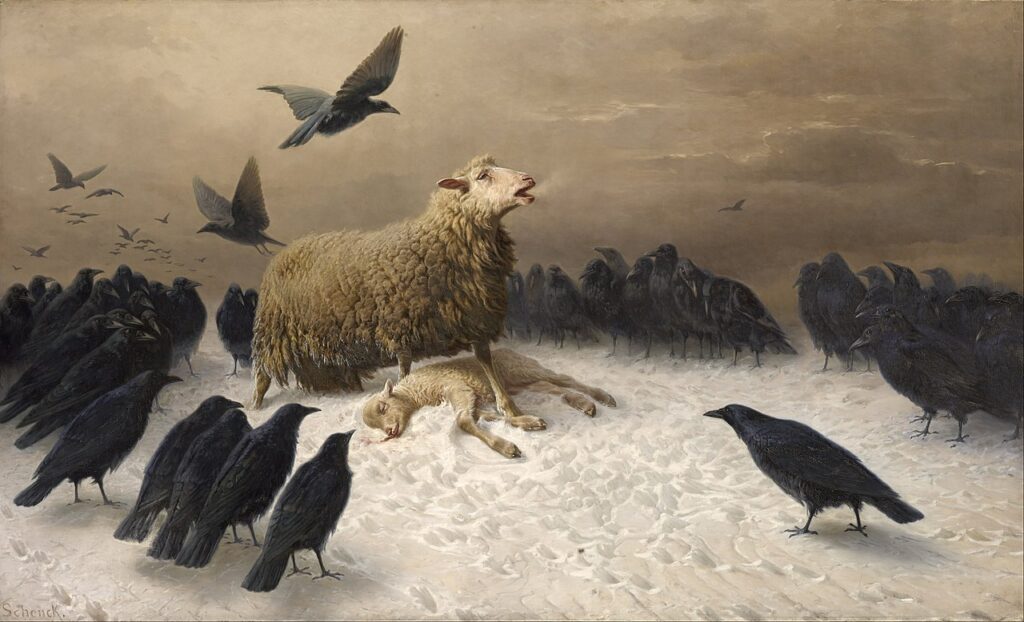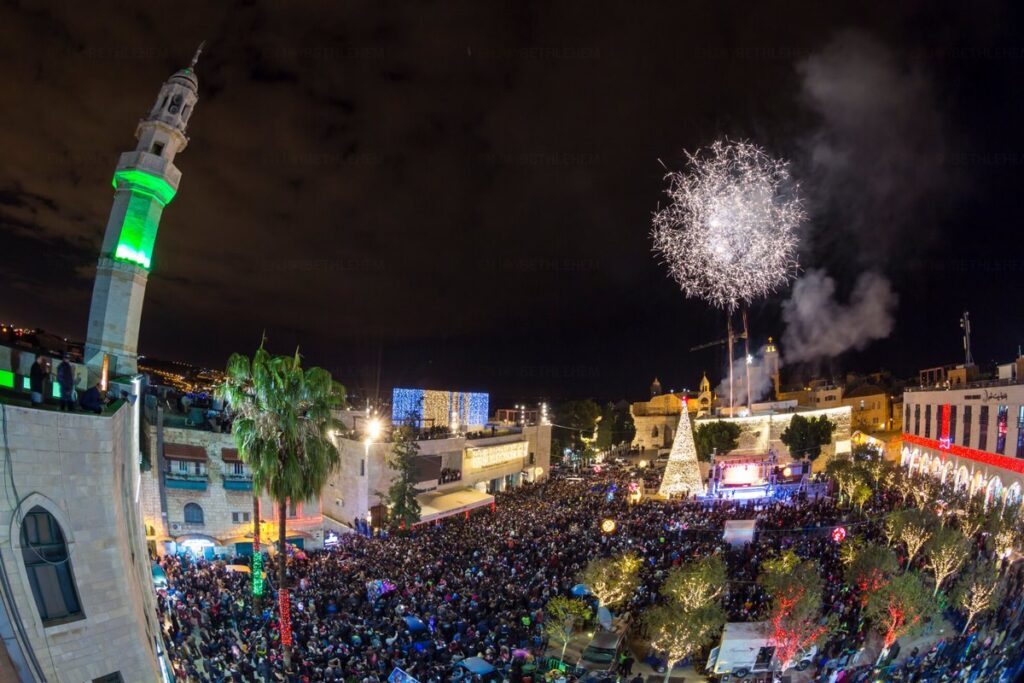Christmas Eve in Bethlehem Has Been Cancelled

“I spent four months studying in Israel at the Tantur Ecumenical Institute, which is beautifully situated atop a hill on the southern edge of Jerusalem, overlooking the Judean Hills and Bethlehem. It was an easy 5-minute walk to Bethlehem and, during my stay there, I made several visits to an outdoor café in Manger Square for Turkish coffee and baklava. As Christmas drew near, I eagerly awaited Christmas Eve in the square. Unless you have experienced the holy night spectacle in person, it is nearly impossible to convey what it is like: bedlam. (In fact, Bedlam is another name for Bethlehem: ‘Bethlem,’ meaning, in Arabic, ‘House of Meat,’ ‘House of Bread,’ or even, perhaps, “House of War.’)”—Rev. Robin White
Wing + Prayer
By The Reverend Robin White

“The annual Christmas display in Bethlehem has been cancelled by Palestinian authorities ‘in honor of Hamas martyrs’ amid the ongoing conflict with Israel. Bethlehem Municipality announced the plans to do away with the traditional Christmas tree and festive decorations in Manger Square, which has seen Christmas decorations ever since modern celebrations of the season began. It’s the first time festive decorations will not be seen in the spot which is said to have been where Jesus Christ was born since 1988, when Christmas was cancelled due to the first Intifada.”—Gemma Parry, DailyMail.com

PENDLETON South Carolina—(Hubris)—December 2023—In 1984, I spent four months studying in Israel at the Tantur Ecumenical Institute, which is beautifully situated atop a hill on the southern edge of Jerusalem, overlooking the Judean Hills and Bethlehem. It was an easy walk to Bethlehem and, during my stay there, I made several visits to an outdoor café in Manger Square for Turkish coffee and baklava.
As Christmas drew near—“Oh Little Town of Bethlehem”—I eagerly awaited Christmas Eve in the square. Unless you have experienced the holy night spectacle in person, it is nearly impossible to convey what it is like: bedlam. (In fact, Bedlam is another name for Bethlehem: “Bethlem,” meaning, in Arabic, “House of Meat,” “House of Bread,” or even, perhaps, “House of War.”)
As my friends and I stood shoulder to shoulder with the assembled crowds, waiting to enter through the metal detectors, I felt as though I were stuck in a cattle chute. At one point, as the hordes pressed in, I felt something poking into my rib cage. I turned in place to see an Israeli soldier standing so near me that the barrel of the automatic weapon slung over his shoulder was jabbing into my back.
I saw Santa nearby and wondered if he had an AK-47 in the pack on his back.
A helicopter with a spotlight circled overhead and, finally, my friends and I were through the checkpoint and standing in the midst of that holy place, Manger Square. Red and green Christmas lights were strung throughout the area: their raucous blinking reminded me of a carnival. The noise, the helicopter circling to scan the throngs, its light piercing so, so much darkness, the smell of tobacco and alcohol, stumbling drunks, street urchins begging for spare coins, merchants bartering for tacky souvenirs—all this pandemonium drowned out the choirs, which had come from all over the world to perform.
As I stood amidst the chaos slack jawed, I saw an image I will never, ever forget. At the very top of the Church of The Nativity, the church built over the place where Jesus is presumed to have been born, there was a huge cross. Silhouetted against that cross was a soldier . . . cradling an assault weapon. At the highest point in the square, right there at the intersection of Star and Shepherd’s streets, he stood with his weapon nestled against his body, keeping watch over the flocks by night.

![]()
Thirty-four years ago, an infant girl, (I will call her “Betsy”) was born prematurely with a form of dwarfism called Spondyloepiphyseal dysplasia congenita (SEDc). From the moment of her delivery, Betsy confronted one life threatening complication after another. My installation as pastor of Betsy’s family church came shortly after her birth. I visited her at the children’s hospital where she was cared for and where she lived off and on for the first couple of years of her life. Betsy was the first infant in her state to come home from the hospital on a ventilator with 24-hour nursing care. From the very start, she was a feisty fighter, and made her way forward in the world.
One Christmas Eve, while serving that congregation, I called the children forward for the Children’s Sermon. I had a sweet story for them about a little lame lamb born in the stable in Bethlehem. As a host of children dressed in frilly dresses or tiny suits and bow ties crowded around me and settled in for the story, I heard a bizarre sound reverberating through the sanctuary. Click, click, click, click.
What was it? I strained to see through the candlelit space. Click, Click, Click.
Then, I saw her, and my heart jumped up into my throat. She had never before come to church and I certainly did not expect her on this particularly cold Christmas Eve, but there she was, ringlets in her hair, in a dark green velvet dress with a crisp white petticoat.
Betsy slowly made her way up the central aisle of the church using the tiniest walker I had ever seen. Click, click, click. As she finally settled into a spot on the chancel steps, you could hear a pin drop in that packed worship space.
With my heart still in my throat I struggled to hold back my tears. I thought to myself, “This is the story I have chosen. I have nothing else prepared. Here goes . . .”
The story ends with the little lame lamb snuggling in next to baby Jesus, offering all that she has . . . her warmth.
![]()
Christmas in Bethlehem is cancelled this year. It is not the first time. Again, there is too much violence, too much fear and anger and chaos for festivities attended by a host of multi-ethnic worshippers.
In Gaza, Israeli babies are being held hostage. In Gaza, in hospitals without power, premature infants have been removed from incubators and placed together in one bed, each wrapped in foil and situated next to hot water bottles in an attempt to keep them warm. Israeli tanks are stationed at the hospital gates, keeping watch . . . and, at the time of my writing this, snipers and drones are allegedly firing into the hospital.
Christmas is cancelled until further notice. The House of Bread has, once again, become The House of War.
![]()
Author’s Note: Recently, I Googled my little lamb of so long ago, “Betsy,” who now, at 34, uses a wheelchair and crutches to make her sure way through the world. Despite her 2’6” height, she is pretty much a typical young adult these days; perhaps not so typical, though, in the eyes of those of us who watched her weather the many surgeries, adversities, and health crises of her very early life. What doesn’t surprise me is that she is still sharing her warmth and strength with the world, in very public ways.
2 Comments
Diana
Robin, this is a most amazing story. It’s hard to believe Betsy overcame so many challenges and offers her warmth and much more to her world. I spent Epiphany in Bethlehem in 1966. My memories are very different, of course. Very peaceful. All I remember was the noise of the muezzin coming from across the square at the same time the bells were ringing at the Church of the Nativity, a very odd combination.
Robin White
Thank you Diana, for your thoughtful comments. I was not in Israel for Epiphany, but would hope for a more peaceful event, indeed! I love the idea of the bells of the Church of the Nativity ringing, coexisting with, accompanying the Muslin call to prayer. The idea of that dissonance gives me chills and at the same time, warms my heart!